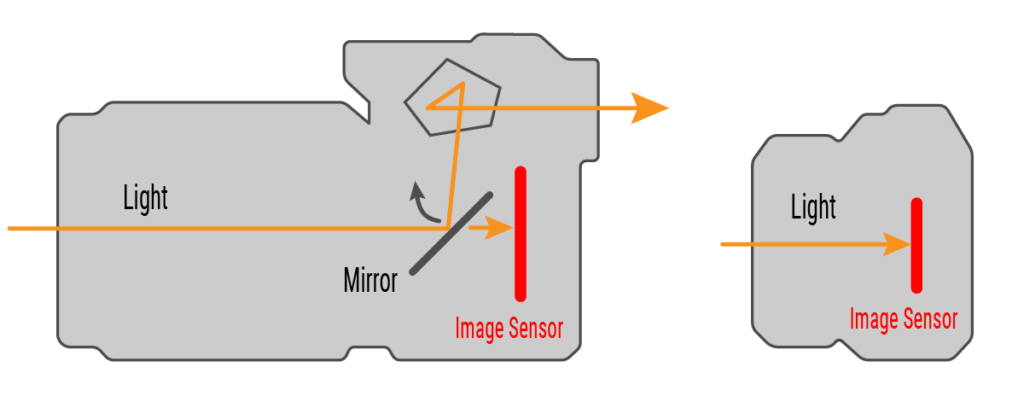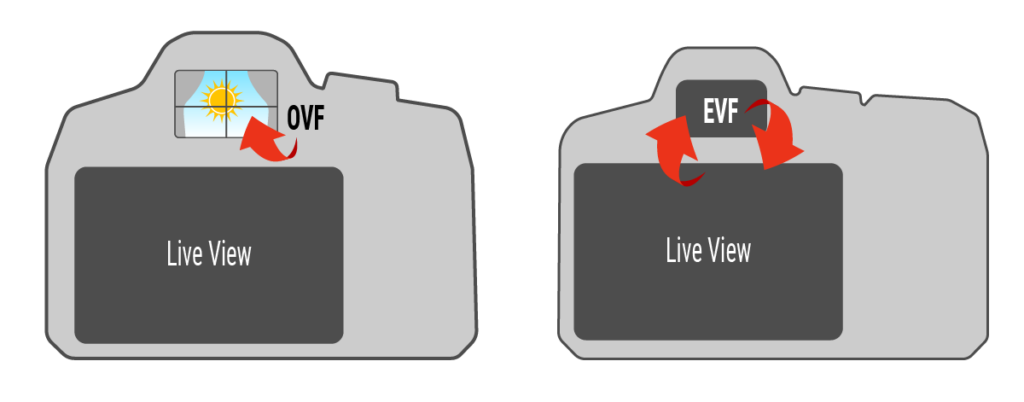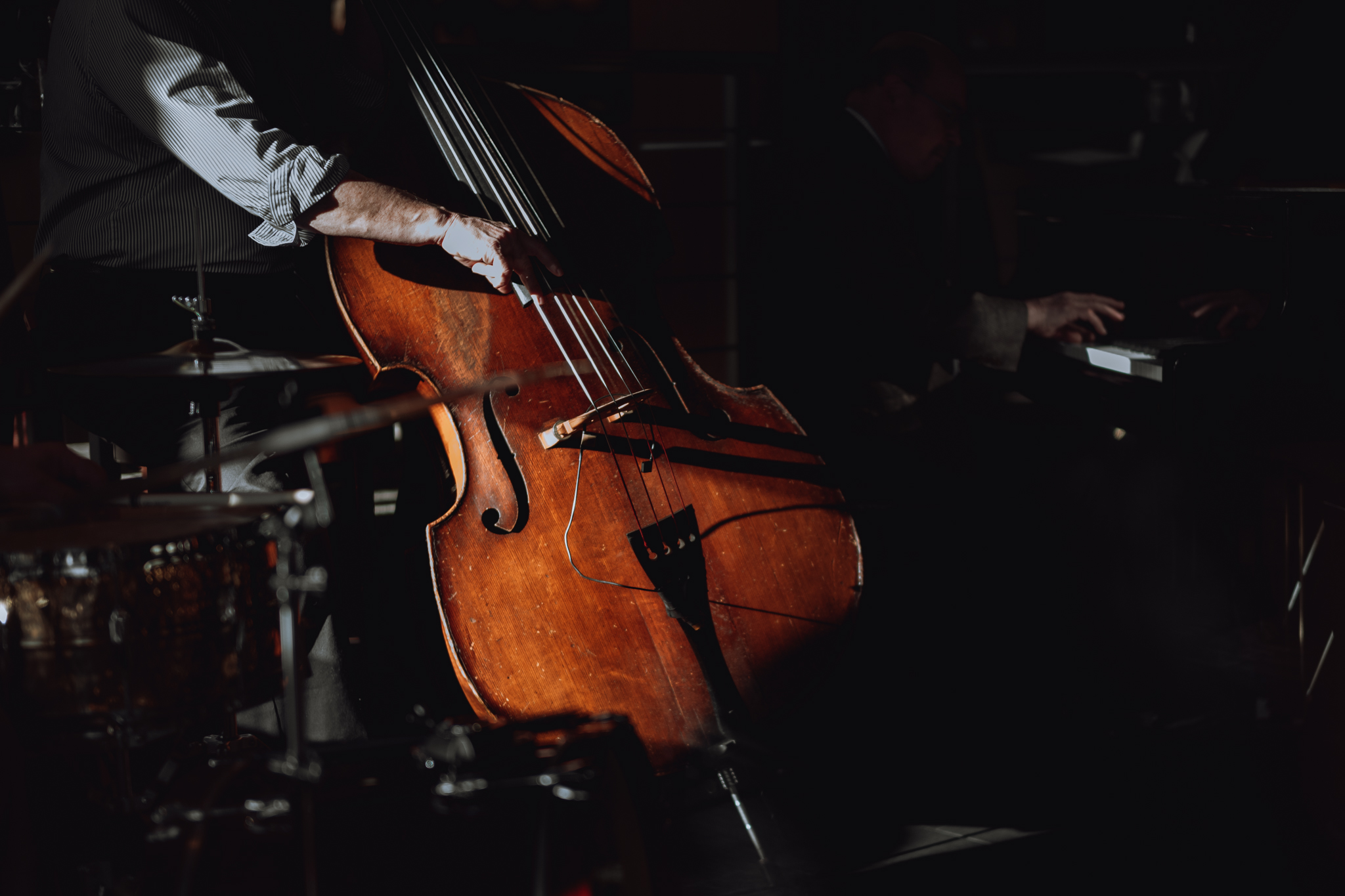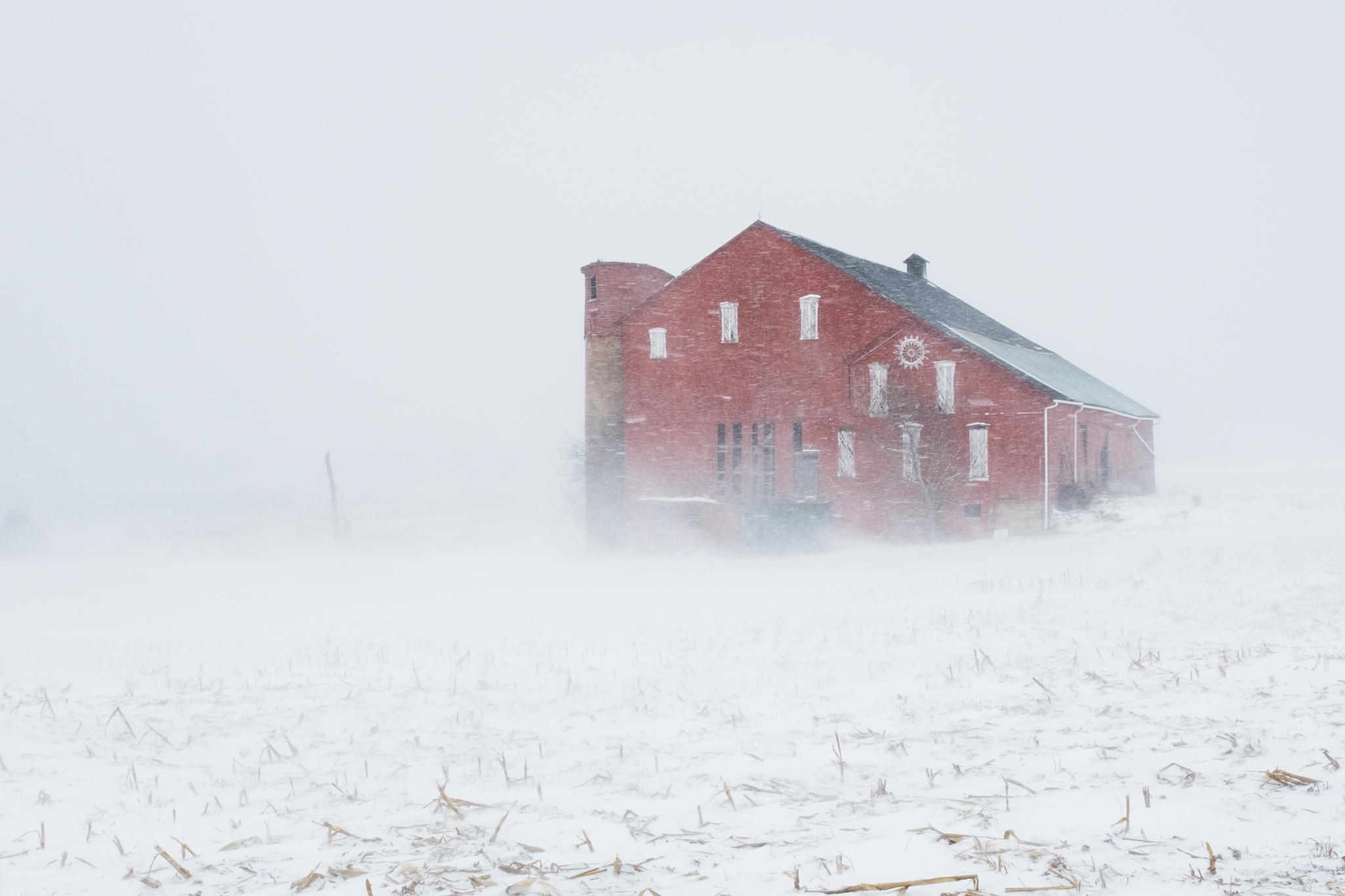One of the first significant choices you will encounter as you get into photography is deciding between a DSLR (Digital Single-Lens Reflex) and a Mirrorless camera. Both camera types have unique features and benefits, making them appropriate for different scenarios and preferences. DSLRs are based on older SLR cameras and are being replaced by newer mirrorless models.
Although they may seem like entirely different beasts, the primary distinction between DSLR and Mirrorless cameras is how they operate. Both are designed to achieve the same purpose: to take a photograph—the main differences are in the mechanics.
Similar to vehicles, you can think of a DSLR as a gas-powered vehicle and a Mirrorless as an electric-powered one. They’re both cars and function similarly. Besides personal preferences, one isn’t necessarily better than the other to travel from Point A to Point B. You’ll get to your destination as long as either doesn’t break down along the way.
When it comes to choosing which type of camera is right for you, there are some stand-out features and functionality you will need to consider. Some may be relevant to your needs, and some not. You won’t necessarily get better pictures with a newer mirrorless camera, but they can be more intuitive and user-friendly, which translates into more fun behind the lens.

What Does Mirrorless Mean?
DSLRs (left) possess an internal mirror that reflects light up into an optical viewfinder (OVF), i.e., the eyepiece you look through. When you fully press the shutter button, the mirror flips up out of the way so light can reach the image sensor. Mirrorless cameras (right), as their name suggests, do not have a mirror. Instead, the light directly hits the sensor, displaying the image in an electronic viewfinder (EVF) or the LCD screen.
DSLRs are like gas-powered vehicles, and Mirrorless cameras are like EVs.
Viewfinders and Live View
Photographs are composed either through the viewfinder (eyepiece) or using the LCD screen on the back of the camera. Similar to a smartphone, composing on the LCD uses Live View, which shows a real-time preview of the scene before you take the photograph. Mirrorless and DSLR cameras share similarities in viewing or composing a picture but also have significant differences.
Mirrorless is the new darling and has functionality not available on DSLRs. One particular distinction is the viewfinder if your camera has one. The viewfinder on a DSLR is called an Optical Viewfinder (OVF) because it employs looking through the lens or optic. This is similar to looking through a window and does not display an exposure preview. You must rely more on the camera’s light meter and your experience, which has a steeper learning curve.
Conversely, the viewfinder on a mirrorless camera is called an Electronic Viewfinder (EVF), which shows a small Live View screen that allows you to see the same changes to the exposure as you would using the LCD—a handy feature for sure. Electronic viewfinders are also beneficial in bright conditions because the glare from the LCD can make it challenging to see any changes you make.
Be aware that Live View and an electronic viewfinder consume more battery power, so be sure to carry a spare battery or two, especially in colder temperatures.

DSLR Optical Viewfinder (OVF) and Mirrorless Electronic Viewfinder (EVF)
DSLRs (left) possess an optical viewfinder (OVF) and Live View, which show a different picture preview. OVFs are like looking through a window and will not display changes to the exposure as Live View. Mirrorless cameras (right) have an electronic viewfinder (EVF) and Live View that show identical picture previews.
DSLRs have optical viewfinders (OVF) and mirrorless have electronic viewfinders (EVF).
Size and Portability
When mirrorless cameras first appeared, a central selling point was their more compact size and lighter weight compared to bulky DSLRs. Naturally, this appealed to many photographers. But fast-forward to today, and numerous mirrorless cameras look just as big as DRLRs, albeit the lenses tend to be lighter due to improved design and manufacturing. Still, mirrorless cameras are generally smaller, making them great to travel with and carry around for daily use.
A smaller camera is easier to carry and encourages you to bring it along more often. Pare down to a single lens, preferably a prime with an aperture as wide as your budget allows. You’ll often find more interesting photos in the most unlikely places than if you plan a session. How often have you been out and told yourself, “Shoot, I wish I had my camera!?” Compare that to the number of arranged photo outings that resulted in little more than a good walk or hike.
Your choice of subject matter ultimately determines gear selection. The ideal camera that suits every situation and fits neatly in your pocket doesn’t exist—yet. Nature and wildlife photographers have different gear requirements than street photographers. Birders and other wildlife photographers require the longer reach of a large telephoto lens, as do those capturing sports or anything at a distance. Combine camera gear, a sturdy tripod, and a backpack, and you suddenly have a lot of heavy equipment to lug around. But that’s par for the course. Street and travel shooters tend to go lite, often using a single lens, so they can be as free to move around as possible.
What’s your subject, and how comfortable are you carrying around camera gear? How little can you take and still be effective in the field? You might be surprised at how little you actually need. Having a collection of lenses at the ready sounds nice, but it can get in the way more than help as you’ll rarely, if ever, use them all. Although mirrorless cameras are usually smaller in size and weight than DSLRs, the heft of multiple lenses and countless other “essential” accessories adds up.
Recording Video
Mirrorless cameras are the preferred choice for many videographers. Their Electronic Viewfinders (EVFs) provide a real-time preview of exposure, white balance, and other essential video settings, eliminating much of the guesswork when setting up a shot. Advancements in mirrorless technology often boast fast and accurate autofocus systems tailored explicitly for video, allowing you to track moving subjects smoothly and avoiding the “focus hunting” observed in many DSLRs.
Additionally, many mirrorless models come with In-Body Image Stabilization (IBIS), a blessing for handheld videography, offering smoother footage without needing external stabilizers. With their compact form factor, many mirrorless cameras are easier to adapt, rig, and stabilize for various scenarios. Some models’ smaller footprint and weight make them an excellent fit for gimbals, drones, and other stabilizing equipment.
Although mirrorless cameras and DSLRs can produce excellent video, mirrorless models tend to offer more modern video-centric features, making them particularly appealing to those who like to capture moving images and still photographs. DSLRs can record video only up to 4K, which is plenty for most scenarios, but you’ll need to look at mirrorless cameras if you need more resolution.
Mirrorless cameras are the preferred choice for many videographers—pro or otherwise.
Lens Compatibility
Mirrorless camera systems have ushered in a wave of cutting-edge lens technologies and designs. Many of these systems offer faster lenses (with wider apertures) that may be unavailable or considerably bulkier in the DSLR format. This evolution suggests that users can expect lenses with superior optical qualities and functionalities explicitly tailored for mirrorless cameras.
But while the promise of advanced lens technologies is enticing, a financial consideration must be made. Transitioning to native mirrorless lenses to fully utilize the system’s advantages could represent a significant investment. Even though you can use lens adapters to bridge the compatibility between DSLR lenses and mirrorless bodies, not all DSLR lenses perform optimally when adapted. Some might experience reduced autofocus speeds or accuracy, and there could be other unpredictable behaviors when mixing lenses and bodies from different ecosystems.
Not all DSLR lenses perform optimally when adapted to a mirrorless camera.
The Future is Mirrorless
The camera industry has switched to mirrorless and no longer intends to develop DSLRs, but you can still get new ones online and at local camera shops. The mass exodus of DSLR users to the newer mirrorless systems has made the used market for this “outdated” tech plentiful. You can often find a great deal on a like-new DSLR that captures images as beautifully as current mirrorless models.
Mirrorless is here to stay, at least until the next technology breakthrough. If you haven’t made a camera purchase yet and want to future-proof yourself as best you can, go with a mirrorless over a DSLR—there is no question unless the budget is of concern. Those who own a DSLR don’t need to upgrade unless they want to or need access to the newer tech. Petrol-powered vehicles do just as fine a job as electric ones in their respective role; cameras are the same.
Although mirrorless cameras technically outperform DSLRs in several key areas, including image quality, they have nothing to do with the image concept—the reason you are making the photograph. “Good” pictures begin with an idea, hopefully yours. Technical rendering is always secondary to the principal vision of the artist. For “without a vision, the people perish.”
Ready to Learn?
SIGN UP FOR A CLASS TODAY
Shutterbug Training is located in Columbus, Ohio, and offers in-person classes and private photography instruction to individuals and groups. Virtual training is available upon request.




